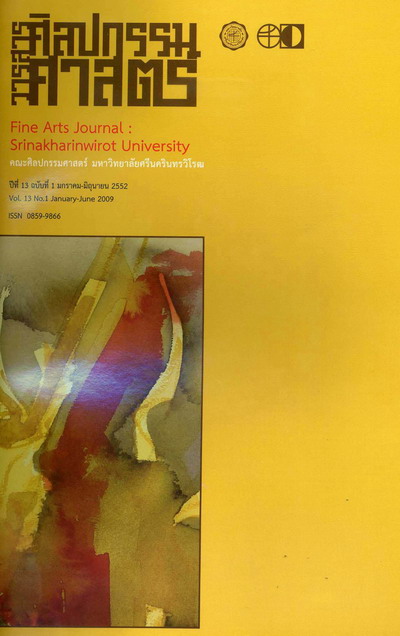The Evolution of “Sarathee”
Abstract
1. Sarathee Song Chan has its origin since the Ayudhaya Eraas when it was used to play accompanying with Pleng-Char called “Pleng-Rueng-Saratee” with 3 sections. Later it was played accompanying Khon and Lakorn. The original Sarathee Song Chan was popular until the end of King Rama III, Phra Pradit Paireo (Mee Duriyangkoon) extended the song into Sam Chan and sending through Sepa. It was very popular at that time until the age of Sarathee Tao, then it was developed as Chan Dio in order to sing and get. It was played since nowadays. However, it was about King Rama VI reign, there were specialists who played Dio (solo) Sarathee of Pee Nai, Ranad-Eak, Ranad-Tum, Khong Wong-yai, Khong Wong-lek, etc.
2. Sarathee Sam Chan of Dio (solo) Ranad-Eak is the kind of Nathap Probkai (drum rhythmic pattern) with Sam Chan and 3 sections which verse of Dio Sarathee Sam Chan of Ranad-Eak by Kru Natthapong Sowatara as follows:
Section I: Including the playing of squeezing the whole round through gleaning beat, flipping, unbolting, pressing, squeezing some parts, and widen beating.
Section II: Including the playing of gleaning beat through changing verse, trembling beat with pressing, and gleaning beating.
Section III: Including the playing of gleaning beat through thrilling verse, swinging beat as pairs, trembling beat and gleaning beat at the final part as ending.
3. The researcher collects context of Thai classical music “Sarathee” such as Sarathee Song Chan, Pleng-char-Rueng-Sarathee, Sarathee Thao, Sarathee Mon, and Dio (solo) Sarathee Sam Chan of Ranad-Eak.
การศึกษาเพลงสารถี
1. เพลงสารถีอัตรา 2 ชั้น มีตั้งแต่สมัยกรุงศรีอยุธยา ใช้เป็นเพลงสำหรับบรรเลงรวมอยู่ในประเภทเพลงช้าเรียกว่า “เพลงเรื่องสารถี” มีทั้งหมด 3 ท่อน ภายหลังได้นำมาใช้เป็นเพลงร้องประกอบการแสดงโขน ละคร เพลงสารถี2 ชั้นเดิม ได้รับความนิยมเรื่อยมาจนถึงราวๆ ปลายรัชกาลที่ 3 แห่งกรุงรัตนโกสินทร์ พระประดิษฐไพเราะ (มีดุริยางกูร) ได้แต่ง ขยายขึ้นเป็นอัตรา 3 ชั้นครบทั้ง3 ท่อนแล้วใช้ส่งเสภา เป็นที่นิยมมากในสมัยนั้น จนกระทั่งถึงยุคที่นิยมเพลงเถาจึงมีผู้นำเพลงสารถีมาตัดลงเป็นอัตราชั้นเดียวทั้งทางร้องและทางรับ ใช้บรรเลงร้องและรับจนครบเถาสืบมาจนกระทั่งทุกวันนี้ ประมาณกันว่าในสมัยรัชกาลที่ 6 ผู้ชำนาญการดนตรีได้นำเพลงสารถีมาประดิษฐ์เป็นทางเดี่ยวสำหรับบรรเลงอวดฝีมือกัน เช่น ปี่ใน ระนาดเอก ระนาดทุ้ม ฆ้องวงใหญ่ ฆ้องวงเล็ก ฯลฯ
2. เพลงสารถี 3 ชั้นทางเดี่ยวระนาดเอก เป็นเพลงประเภทปรบไก่ ใช้จังหวะหน้าทับปรบไก่ 3 ชั้น มีทั้งหมด 3 ท่อน ซึ่งลักษณะของสำนวนกลอนในการบรรเลงเดี่ยวเพลงสารถี 3 ชั้นทางระนาดเอก บรรเลงโดย ครูนัฐพงศ์ โสวัตร มี ลักษณะ ดังนี้
ท่อนที่ 1 มีลักษณะการบรรเลง คือ การขยี้ตลอดทั้งเที่ยวโดยการตีเก็บ สะบัด สะเดาะ คาบลูกคาบดอก การตีขยี้บางวรรคบางตอน และการตีถ่าง
ท่อนที่ 2 มีลักษณะการบรรเลง คือ การตีเก็บโดยมีการใช้สำนวนกลอนที่มีความพลิกแพลง การตีรัวคาบลูก คาบดอกและการตีเก็บ
ท่อนที่ 3 มีลักษณะการบรรเลง คือ การตีเก็บโดยการใช้สำนวนกลอนที่โลดโผน การตีเหวี่ยงเป็นคู่ต่างๆ การตี รัว และการตีเก็บในช่วงสุดท้ายของเพลงเพื่อการลงจบ
3. รวบรวมบันทึกโน้ตเพลงสารถีทุกบริบท ได้แก่ เพลงสารถี 2 ชั้น เพลงช้าเรื่องสารถีเพลงสารถีเถา เพลงสารถี มอญ และเพลงเดี่ยวสารถี3 ชั้น ทางระนาดเอก






